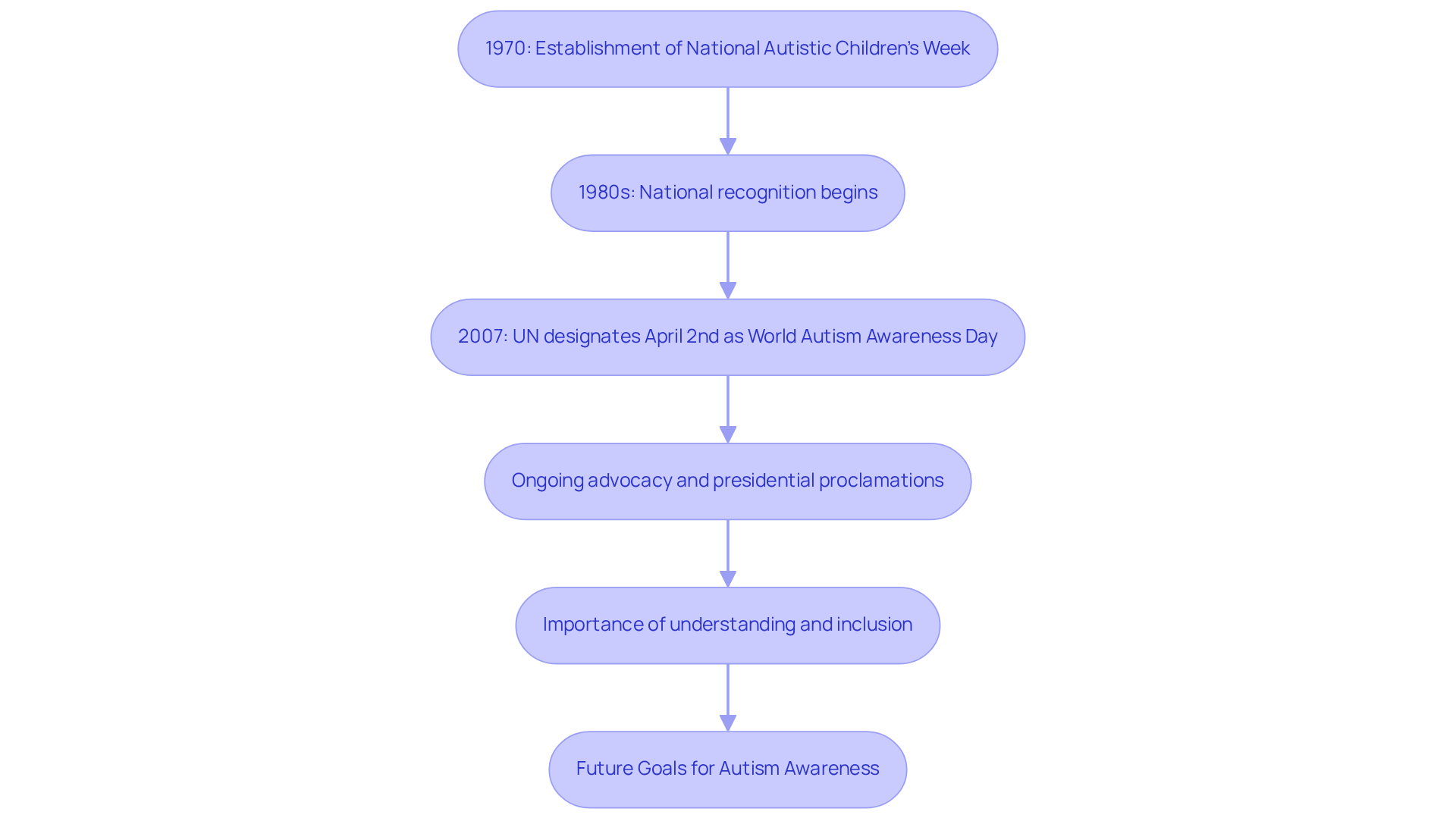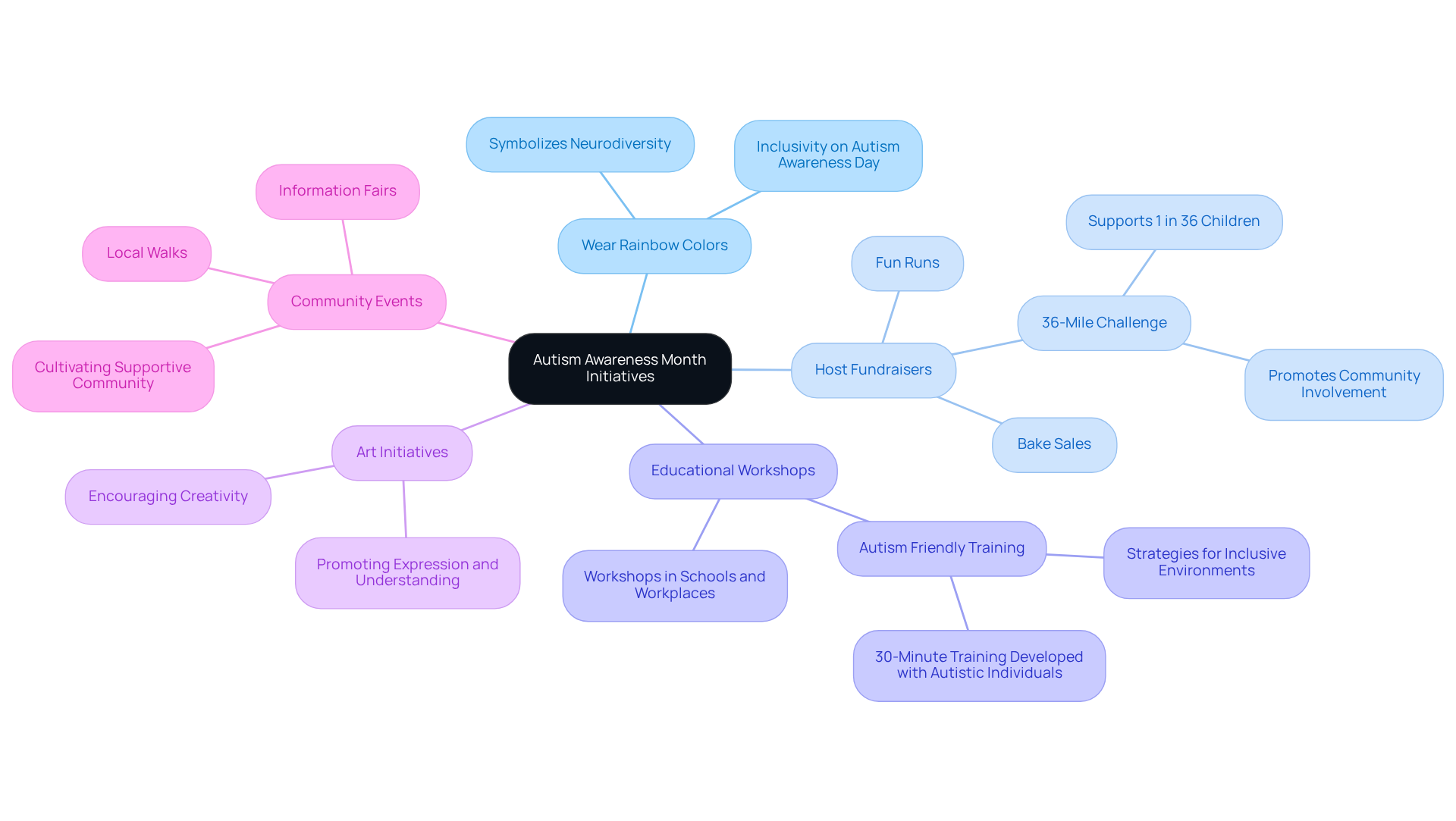Overview
World Autism Awareness Month, observed in April, holds great significance in fostering understanding and acceptance of autism spectrum disorder (ASD). This month serves as an opportunity to educate the public about the challenges faced by individuals with autism and their families. By sharing historical context, statistics, and various initiatives, we can promote empathy, reduce stigma, and encourage community support for those on the spectrum. Together, we can create a more inclusive environment that embraces every individual’s unique journey.
Introduction
World Autism Awareness Month stands as a vital reminder of our collective journey toward understanding and embracing autism spectrum disorder (ASD). With a staggering statistic of 1 in 31 children diagnosed with ASD, this month not only sheds light on the challenges faced by individuals and their families but also highlights the importance of nurturing empathy and diminishing stigma within our communities.
As we navigate the delicate balance between mere awareness and true acceptance, we must ask ourselves: how can we actively foster a culture that values neurodiversity and celebrates the unique strengths of those on the spectrum?
Together, let us explore ways to create a supportive environment where every individual is recognized and valued.
Define Autism Awareness Month and Its Significance
Every April, during world autism awareness month, we focus on fostering understanding and knowledge of autism spectrum disorder (ASD). This month, recognized as world autism awareness month, serves as a vital platform to inform the public about the challenges faced by individuals with developmental disorders and their families. Its significance lies in fostering empathy, reducing stigma, and encouraging acceptance within our communities. By enhancing our understanding, we can create a more inclusive environment that acknowledges the unique strengths and needs of those on the spectrum.
In 2022, the CDC reported that 1 in 31 children were identified with ASD, underscoring the urgency of our efforts. During world autism awareness month, successful initiatives have included community seminars and educational programs that offer expert advice on common challenges faced by parents and caregivers. These educational initiatives have been shown to greatly improve public comprehension, leading to better support networks and resources for individuals on the autism spectrum.
Moreover, the financial impact on families is significant, with the average cost of supporting a person with autism spectrum disorder reaching $60,000 annually. This highlights the financial difficulties families encounter and the importance of raising awareness. Ultimately, Neurodiversity Awareness Month benefits individuals on the spectrum by promoting acceptance and understanding, paving the way for a more supportive environment. We encourage everyone to take part in these conversations and share their experiences, helping to build a more compassionate community.

Trace the History and Evolution of Autism Awareness Month
April is a significant month for raising awareness about autism spectrum disorder, particularly during World Autism Awareness Month, which was first established in 1970 by the Society for Autistic Individuals as National Autistic Children's Week. Over the decades, World Autism Awareness Month has gained national recognition through presidential proclamations and global acknowledgment, evolving into a vital platform for advocacy. As we look ahead to 2025, the numerous proclamations made have played a crucial role in amplifying the visibility of autism-related issues. Notably, in 2007, the United Nations designated April 2nd as World Autism Awareness Month, marking a pivotal moment for international understanding and support.
Recent statistics reveal that 1 in 31 children in the U.S. are identified with a developmental disorder, underscoring the importance of ongoing understanding and support. The focus has shifted to World Autism Awareness Month, highlighting the importance of not just recognition but also a deeper understanding and inclusion of individuals with autism in all aspects of society. Christopher Banks, President and CEO of the Society for Individuals with Developmental Disorders in America, highlights this urgency: "It’s important to recognize this improvement; however, the increased prevalence rates mean we urgently need increased access to quality supports and services at the federal and state level." This evolution calls for nurturing an environment where individuals are accepted and valued, moving beyond outdated notions of understanding to embrace a more inclusive approach.
As we reflect on these developments, let us consider how we can contribute to a society that truly values every individual. How can we ensure that those on the spectrum feel recognized and included? Sharing experiences and supporting one another can lead to meaningful change. Together, we can foster a community that not only recognizes but also cherishes the diversity of all individuals.

Engage in Activities and Initiatives for Autism Awareness Month
Participating in events during world autism awareness month can significantly enhance community understanding and acceptance of autism. Consider these impactful initiatives:
- Wear Rainbow Colors: While blue has historically represented autism support, wearing rainbow colors on Autism Awareness Day (April 2nd) symbolizes neurodiversity and inclusivity. This shift reflects a broader understanding of neurodevelopmental representation, inviting everyone to join in.
- Host Fundraisers: Organize community events such as bake sales, fun runs, or auctions to raise funds for autism-related charities. Initiatives like the 36-mile challenge in April, particularly during world autism awareness month, promote community involvement and support for the 1 in 36 children identified with the condition, showcasing how collaborative actions can truly make a difference.
- Educational Workshops: Conduct workshops in schools and workplaces to educate others about autism, fostering a culture of understanding and acceptance. Programs like the 30-minute Autism Friendly Training, developed with input from autistic individuals, offer practical strategies for creating inclusive environments.
- Art Initiatives: Encourage creativity through art initiatives that represent the experiences of individuals with developmental differences, promoting expression and deeper understanding.
- Community Events: Engage in local activities such as walks or information fairs to connect with others and spread the message of acceptance. These gatherings not only raise awareness but also cultivate a supportive community around initiatives related to developmental disorders.
As Autism Speaks mentions, "Together, we’ve driven innovative research, promoted essential advocacy, and created opportunities in education, healthcare, and employment, shaping a brighter future for individuals on the spectrum." By actively participating in these initiatives, we can foster a culture of acceptance and understanding, making a significant impact on the lives of those affected by developmental disorders. Moreover, it’s essential to remember that promoting understanding of developmental disorders should extend beyond April, encouraging continuous education and support throughout the year.

Differentiate Between Autism Awareness and Acceptance
World Autism Awareness Month serves as a vital platform for educating the public about autism, while Autism Acceptance Month further champions the inclusion of individuals with autism as essential members of our society. While awareness focuses on recognizing neurodiversity, acceptance emphasizes understanding and valuing the unique contributions that autistic individuals bring to our communities. This shift from mere awareness to genuine acceptance is crucial for nurturing inclusive practices that support neurodiversity and foster environments where individuals with autism can truly thrive.
Organizations like the Autism Society lead the way in this movement, implementing initiatives such as the Autism Is campaign to promote acceptance through community engagement and educational resources. Surveys indicate that by 2025, a growing understanding of neurodiversity will emerge, with many advocating for a more inclusive approach that uplifts Autistic voices. For example, a project at Themarona Special Needs School revealed that 80.7% of students experienced an increase in self-acceptance, showcasing the positive outcomes of acceptance initiatives.
This evolution in perspective is not just important; it is essential for building a society that respects and empowers all its members. Let us come together to foster an environment where everyone, regardless of their neurodiversity, is embraced and celebrated. Your engagement and support can make a significant difference in this journey toward acceptance.

Conclusion
As we conclude this important discussion, World Autism Awareness Month stands as a vital opportunity to deepen our understanding and foster acceptance of individuals on the autism spectrum. By shining a light on the challenges faced by those with autism and their families, this month encourages us all to embrace neurodiversity and cultivate a more inclusive environment. The heart of this initiative lies not just in raising awareness but also in promoting genuine acceptance, recognizing the unique contributions that autistic individuals bring to our society.
Key points throughout our exploration highlight the historical significance of Autism Awareness Month, the importance of community engagement through various activities, and the critical transition from mere awareness to heartfelt acceptance. Initiatives such as educational workshops, community events, and fundraising efforts play a pivotal role in enhancing understanding and support for individuals with autism. Moreover, the evolution of this observance reflects a growing recognition of the need for quality support services and the empowerment of autistic voices in our communities.
As we continue on this journey toward acceptance, it is crucial for individuals and communities to actively participate in nurturing an environment that values every person, regardless of their neurodiversity. Engaging in conversations, sharing personal experiences, and supporting initiatives beyond April can create meaningful change. By committing to this cause, we can all contribute to a compassionate community that not only recognizes but also cherishes the diversity of all individuals, paving the way for a brighter, more inclusive future.
Frequently Asked Questions
What is Autism Awareness Month?
Autism Awareness Month, recognized every April, focuses on fostering understanding and knowledge of autism spectrum disorder (ASD) and serves as a platform to inform the public about the challenges faced by individuals with developmental disorders and their families.
Why is Autism Awareness Month significant?
The significance of Autism Awareness Month lies in fostering empathy, reducing stigma, and encouraging acceptance within communities. It aims to create a more inclusive environment that acknowledges the unique strengths and needs of those on the autism spectrum.
What statistics highlight the urgency of Autism Awareness Month?
In 2022, the CDC reported that 1 in 31 children were identified with ASD, underscoring the urgency of efforts to raise awareness and support for individuals and families affected by autism.
What types of initiatives occur during Autism Awareness Month?
Successful initiatives during Autism Awareness Month include community seminars and educational programs that provide expert advice on common challenges faced by parents and caregivers, improving public comprehension and support networks.
What is the financial impact of autism on families?
The average cost of supporting a person with autism spectrum disorder reaches $60,000 annually, highlighting the financial difficulties families encounter and the importance of raising awareness.
How does Autism Awareness Month benefit individuals on the spectrum?
Autism Awareness Month promotes acceptance and understanding, paving the way for a more supportive environment for individuals on the spectrum and encouraging everyone to participate in conversations and share experiences.




